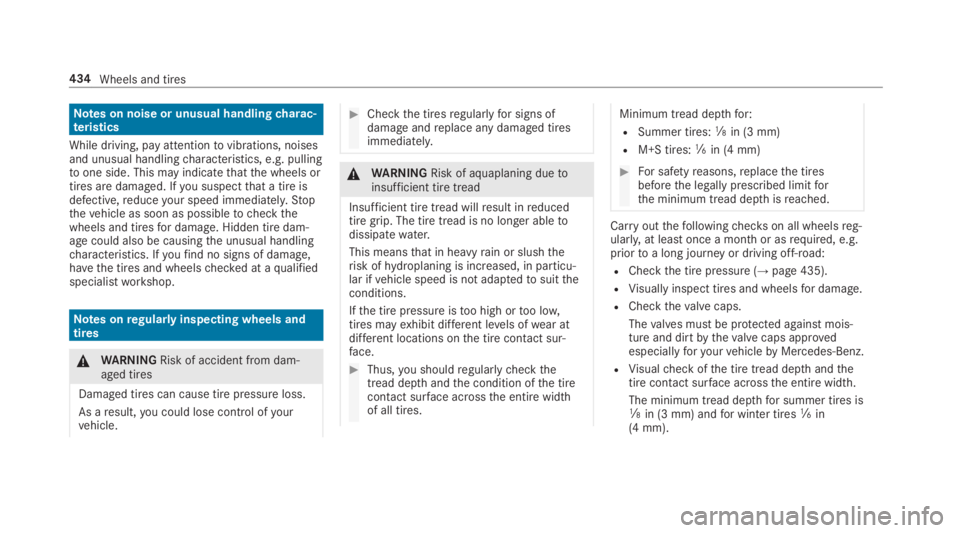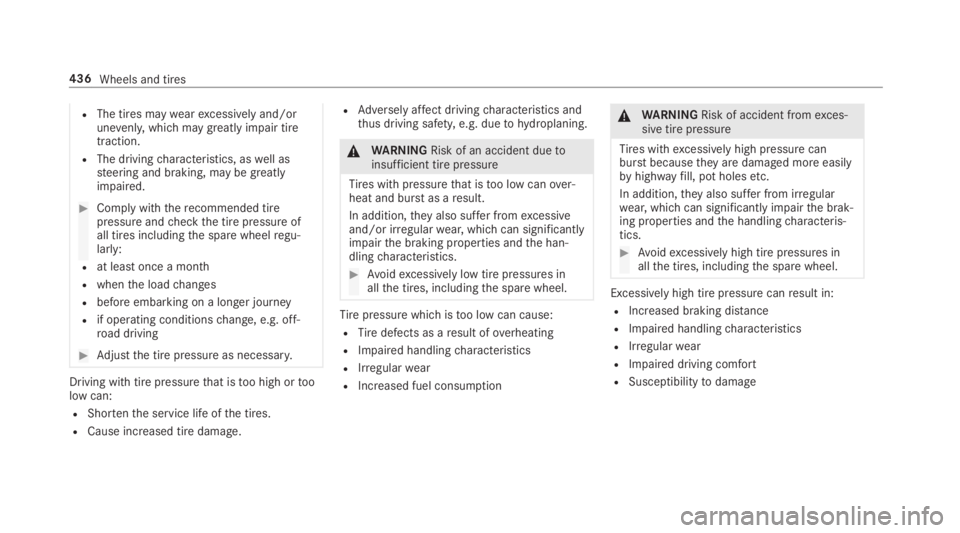2019 MERCEDES-BENZ S CLASS wheel
[x] Cancel search: wheelPage 416 of 578

Tires withrun-flatcharacteristics:
#Observethe information andwarningnotes on MOExtended tires (run-flattires).
Intheevent of aflat tire,thefollowing optionsareavailable depending onyourvehicle's equip‐ment:
RVehicles with MOExtended tires:it is pos‐sibletocontinuethe journeyfor a shortperiod of time. Make sureyou observethenotes on MOExtended tires (run-flat tire)(→page414).
RVehicles with a TIREFIT kit:you canrepairthe tires sothat it is possibletocontinuethejourneyfor a short period of time.Todothis,usethe TIREFIT kit (→page415).
RVehicles with Mercedes me connect:youcan make a callforRoadside Assistance viatheoverhead control panel inthe case of abreakdown (→page 344).
RAllvehicles:changethe wheel(→page 458).
Notes on MOExtended tires (run-flat tire)
&WARNINGRisk of accident when drivingin emergency mode
When driving in emergency mode,the han‐dlingcharacteristics are impaired. e.g. whencornering, when acceleratingstronglyandwhen braking.
#Do notexceedthe permissible maxi‐mum speedfor MOExtended tires.
#Avoid any abruptsteering and drivingmaneuvers aswell as drivingoverobstacles (curbs, pot holes, off-road).This applies, in particular,toa loadedvehicle.
#Stop driving inthe emergency mode ifyou notice:
Rbanging noise
Rvehicle vibration
Rsmoke which smells likerubber
Rcontinuous ESP®intervention
Rcracksin tire sidewalls
#After driving in emergency mode havetherimscheckedbyaqualified special‐istworkshop withregardtotheir furtheruse.
#The defective tire must bereplaced ineverycase.
WithMOExtended tires (run-flat tire),you cancontinuetodriveyourvehicleeven ifthere is atotal loss of pressure in one or more tires. How‐ever,the tire affected must not show any clearlyvisible damage.
You canrecognize MOExtended tiresbytheMOExtended marking which appearsonthe sidewall ofthe tire.
Vehicles with tire pressure monitoring sys‐tem:MOExtended tires may only be used in con‐junction withan activated tire pressure monitor‐ing system.
If a pressure losswarning message appears inthe multifunction display,proceed asfollows:
RCheckthe tirefor damage.
RIf driving on, observethefollowing notes.
414Breakdown assistance
Page 417 of 578

Driving distance possible in emergencymode after the pressure losswarning:
Load condition Driving distance pos‐sible in emergencymode
Partially laden50 miles (80 km)
Fully laden19miles (30 km)
The driving distance possible in emergencymode mayvarydepending onthe drivingstyle.Observethe maximum permissible speed of50mph (80 km/h).
If a tire has goneflat and cannot bereplacedwith an MOExtended tire,you can use astand‐ard tire as atemporary measure.
TIREFIT kitstoragelocation
The TIREFIT kit is located underthe trunkfloor.
Mercedesvehicles:observethe notes intheSupplement. Otherwise,you may notrecognizedangers.
Plug-inhybrid:observethe notes inthe Supple‐ment. Otherwise,you may notrecognize dan‐gers.
1Tiresealant bottle
2Tireinflation compressor
Usingthe TIREFIT kit
Requirements:RTiresealant bottle
REnclosed TIREFITsticker
RTireinflation compressor
RDisposablegloves
You can use TIREFIT tire sealanttoseal perfora‐tion damageof upto0.16in (4 mm), particularlythose inthe tire contact surface.You can useTIREFIT in outsidetemperatures downto-4 °F(-20 °C).
&WARNINGRisk of accident when usingtire sealant.
Inthefollowing situations,the tire sealant isunabletoprovide sufficient breakdown assis‐tance, as it is unabletosealthe tire properly:
RThere are cuts or punctures inthe tirelargerthanthose previously mentioned.
RThe wheelrim is damaged.
RYou havedriven at averylow tire pres‐sure or on aflat tire.
#Do not continue driving.
#Consult aqualified specialistworkshop.
Breakdown assistance415
Page 418 of 578

&WARNINGRisk of injuryand poisoningfrom tire sealant
The tire sealant is harmful and causes irrita‐tion. Do not allow ittocome into contactwith the skin,eyes or clothing, and do notswallow it. Do not inhale tire sealant fumes.Keepthe tire sealantawayfromchildren.
Ifyou come into contact withthe tire sealant,observethefollowing:
#Rinse offthe tire sealant fromyour skinimmediately usingwater.
#If tire sealantgets intoyoureyes,thor‐oughlyrinse outtheeyes using cleanwater.
#If tire sealant has been swallowed,immediatelyrinse outthe mouththor‐oughly and drink plenty ofwater.Do notinducevomiting and seek medicalattention immediately.
#Change out of any clothes contamina‐ted with tire sealant immediately.
#If allergicreactions occur, seek medicalattention immediately.
*NOTEOverheating duetothe tire infla‐tion compressorrunningtoo long
#Do notrunthe tire inflation compressorfor longerthan eight minutes withoutinterruption.
Comply withthe manufacturer's safety notes onthesticker onthe tire inflation compressor.
Havethe tire sealant bottlereplacedeveryfouryears at aqualified specialistworkshop.
#Do notremoveanyforeign objects whichhaveenteredthe tire.
#Affix part1ofthe TIREFITstickertotheinstrument cluster withinthe driver'sfield ofvision.
#Affix part2ofthe TIREFITsticker nearthevalve onthe wheel withthefaulty tire.
#Pull plug4withthe cable and hose5outofthe tire inflation compressor housing.
416Breakdown assistance
Page 427 of 578

Mercedes-Benzrecommends transportingyourvehicle inthe case of a breakdown,ratherthantowing itaway.
Fortowing, use atowrope ortow bar with bothaxles onthe ground. Do not usetow bar systems(→page249).
*NOTEDamagetothevehicle dueto tow‐ingawayincorrectly
#Observethe instructions and notes ontowingaway.
Towing with araised axle:towing should beperformedbyatowing company.
Permittedtowing methods
Vehicle equipment/towingmethod
Bothaxles onthegroundFront axleraisedRear axleraised
Vehicles with automatic transmis‐sionYes, maximum31miles (50 km) at31mph (50 km/h)NoYes, ifthesteering wheel isfixed inthe center position with asteeringwheel lock
4MATICvehiclesYes, maximum31miles (50 km) at31mph (50 km/h)NoNo
Breakdown assistance425
Page 429 of 578

#Do not activatethe HOLD function.
#DeactivateActive Brake Assist (→page 200).
#Shiftthe automatic transmissiontoposition�\\.
#Releasethe electric parking brake.
&WARNINGRisk of accident duetolimi‐ted safety-related functions duringthetowing process
Safety-related functions are limited or no lon‐geravailable inthefollowing situations:
Rthe ignition is switched off.
Rthe brake system or powersteering sys‐tem is malfunctioning.
Rthe energy supply orthe on-board electri‐cal system is malfunctioning.
Whenyourvehicle isthentowedaway, signif‐icantly more effortmay berequiredtosteerand brakethan is normallyrequired.
#Use atow bar.
#Make surethatthesteering wheel canmovefreely, beforetowingthevehicleaway.
*NOTEDamageduetoexcessive tractivepower
Ifyou pullawaysharply,the tractive powermay betoo high andthevehicles could bedamaged.
#Pullawayslowly and smoothly.
Loading thevehiclefor transport
#Observethe notes ontowingaway(→page 426).
#Connectthetow bartothetowingeyetoloadthevehicle.
#Shiftthe automatic transmissiontoposition�\\.
%The automatic transmission may be lockedin position�]intheevent of damagetotheelectrics.Toshiftto�\\, providethe on-
board electrical system with power(→page 423).
#Loadthevehicle ontothe transporter.
#Shiftthe automatic transmissiontoposition�].
#Usethe electric parking braketosecurethevehicle againstrollingaway.
#Only securethevehiclebythe wheels.
Vehicles with ADS PLUS (Adaptive DampingSystem PLUS)
&WARNINGRisk of an accident whentransportingvehicles withAdaptiveDamping System PLUS
Thereduced dampingforces onthevehiclebeing transported can causethevehicle/trailer combinationtostarttoswing.
As aresult, when transportingvehicles withtheAdaptive Damping System PLUS,thevehicle/trailer combination maystarttoskid.Consequently,you could lose control ofyourvehicle.
#When transporting, ensurethat:
Breakdown assistance427
Page 430 of 578

RThevehicle has been loaded ontothe transporter correctly
RThevehicle is secured at allfourwheels with suitabletensioningstraps
RThe maximum permissible speed of35mph (60 km/h) is notexceededwhen transporting
*NOTEDamagetothevehicle from secur‐ing it incorrectly
#After loading,thevehicle must besecured on allfour wheels. Otherwise,thevehicle could be damaged.
#A minimum distance of 4 in (10 cm)upwards and 8 in (20 cm) downwardsmust bekepttothe transport platform.
Transport level is notavailableforthefollowingvehicles:
RMercedes-AMGvehicles
RVehicles with MAGICBODYCONTROL
%Depending onthe model, button1is loca‐ted inthe control panel betweenthesteeringwheel andthe driver's door.
#Toactivate transportlevel:press button1.Indicator lamp2lights up.
Thevehicle israisedby1.2 in (30 mm) com‐paredtothe normal level.
#Press button1again and hold itfor at leastfiveseconds.Thevehicle israised fromtheraised leveltothe transport level.
The transport level isreached when indicatorlamp2flashes andtheMax. Speed 22mphdisplay message appears inthe multifunctiondisplay.
Thevehicle is lowered again inthefollowing sit‐uations:
RWhen drivingfasterthan 22mph (35 km/h).
RAfter selecting a drive program usingtheDYNAMIC SELECT switch.
Thevehicle isthen adjustedtothe height ofthe last active drive program.
#Securethevehicle on allfour wheels afterloading.
#Todeactivate transportlevel:starttheengine whenthevehicle is at astandstill.If transportlevel is activated, indicator lamp2flashes.
428Breakdown assistance
Page 436 of 578

Notes on noise or unusual handlingcharac‐teristics
While driving, pay attentiontovibrations, noisesand unusual handlingcharacteristics, e.g. pullingtoone side. This may indicatethatthe wheels ortires are damaged. Ifyou suspectthat a tire isdefective,reduceyour speed immediately.Stopthevehicle as soon as possibletocheckthewheels and tiresfor damage. Hidden tire dam‐age could also be causingthe unusual handlingcharacteristics. Ifyoufind no signs of damage,havethe tires and wheelschecked at aqualifiedspecialistworkshop.
Notes onregularlyinspecting wheels andtires
&WARNINGRisk of accident from dam‐aged tires
Damaged tires can cause tire pressure loss.
As aresult,you could lose control ofyourvehicle.
#Checkthe tiresregularlyfor signs ofdamageandreplace any damaged tiresimmediately.
&WARNINGRisk of aquaplaning duetoinsufficient tire tread
Insufficient tire tread willresult inreducedtire grip. The tire tread is no longer abletodissipatewater.
This meansthat in heavyrain or slushtherisk ofhydroplaning is increased, in particu‐lar ifvehicle speed is not adaptedtosuittheconditions.
Ifthe tire pressure istoo high ortoo low,tires mayexhibit different levels ofwear atdifferent locations onthe tire contact sur‐face.
#Thus,you shouldregularlycheckthetread depth andthe condition ofthe tirecontact surface acrossthe entire widthof all tires.
Minimum tread depthfor:
RSummer tires:�
Page 438 of 578

RThe tires maywearexcessively and/orunevenly,which maygreatlyimpair tiretraction.
RThe drivingcharacteristics, aswell assteering and braking, may be greatlyimpaired.
#Comply withtherecommended tirepressure andcheckthe tire pressure ofall tires includingthe spare wheelregu‐larly:
Rat least once a month
Rwhenthe loadchanges
Rbefore embarking on a longer journey
Rif operating conditionschange, e.g. off-road driving
#Adjustthe tire pressure as necessary.
Driving withtire pressurethat istoo high ortoolow can:
RShortenthe service life ofthe tires.
RCause increased tire damage.
RAdversely affect drivingcharacteristics andthus driving safety,e.g. dueto hydroplaning.
&WARNINGRisk of an accident duetoinsufficient tire pressure
Tires with pressurethat istoo low canover‐heat and burstas aresult.
In addition,theyalso suffer fromexcessiveand/or irregularwear, which can significantlyimpairthe braking properties andthe han‐dlingcharacteristics.
#Avoidexcessively low tire pressures inallthe tires, includingthe spare wheel.
Tirepressure which istoo low can cause:
RTiredefects as aresult ofoverheating
RImpaired handlingcharacteristics
RIrregularwear
RIncreased fuel consumption
&WARNINGRisk of accident fromexces‐sive tire pressure
Tires withexcessively high pressure canburst becausetheyare damaged more easilybyhighwayfill, pot holesetc.
In addition,theyalso suffer from irregularwear, which can significantly impairthe brak‐ing properties andthe handlingcharacteris‐tics.
#Avoidexcessively high tire pressures inallthe tires, includingthe spare wheel.
Excessively high tire pressure canresult in:
RIncreased braking distance
RImpaired handlingcharacteristics
RIrregularwear
RImpaired driving comfort
RSusceptibilitytodamage
436Wheels and tires